If you’ve ever gone to Ireland or Tasmania and been surprised to see palm trees waving their fronds in the breeze, you’re not alone. Many folks don’t realize that there are cold-hardy palm trees that can thrive in cooler temperate climates and cold weather. In fact, there are numerous varieties of palms that can, with some stipulations.
Bismarck Palm Tree (Bismarckia nobilis)
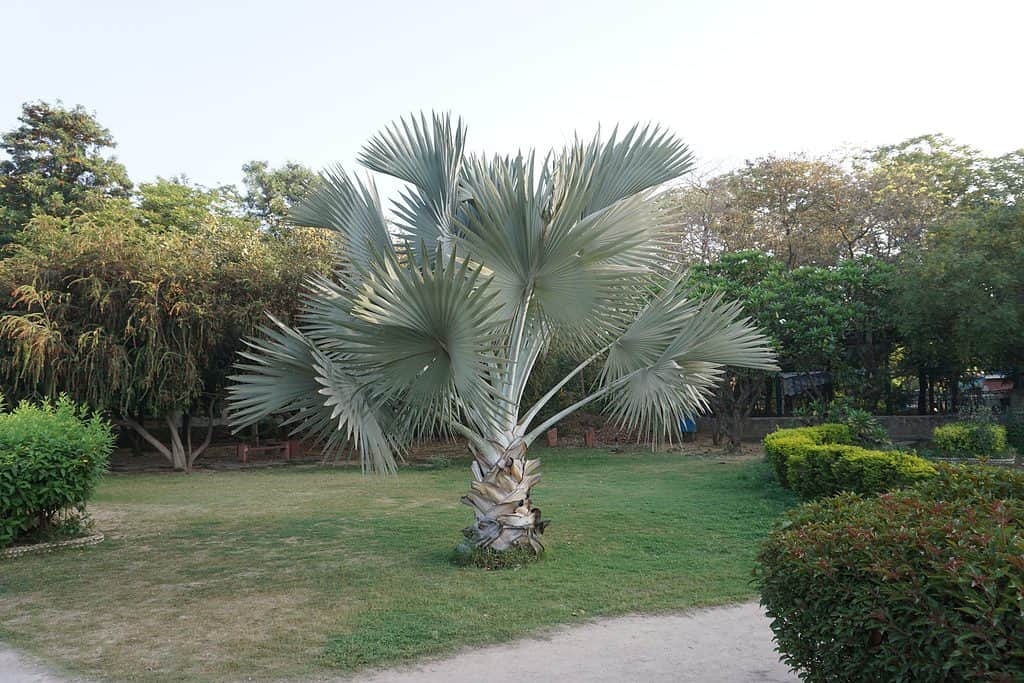
The Bismarck palm tree is a beautiful cold-hardy palm that is native to island nation Madagascar
©Vipul1989/Shutterstock.com
Known botanically as the Bismarckia nobilis, the Bismarck palm tree is a beautiful cold-hardy palm that is native to island nation Madagascar off the mainland of the African continent. It’s not the toughest cold-hardy palm on the list but it certainly can stand both high winds and some heat along with the cold. The tree has silver-green fan-shaped leaves, with a thick round trunk. The tree is low maintenance and tolerates cold down to 25, maybe 15-degrees F, thriving in USDA Zones 9b to 11.
True Date Palm Tree (Phoenix dactylifera)
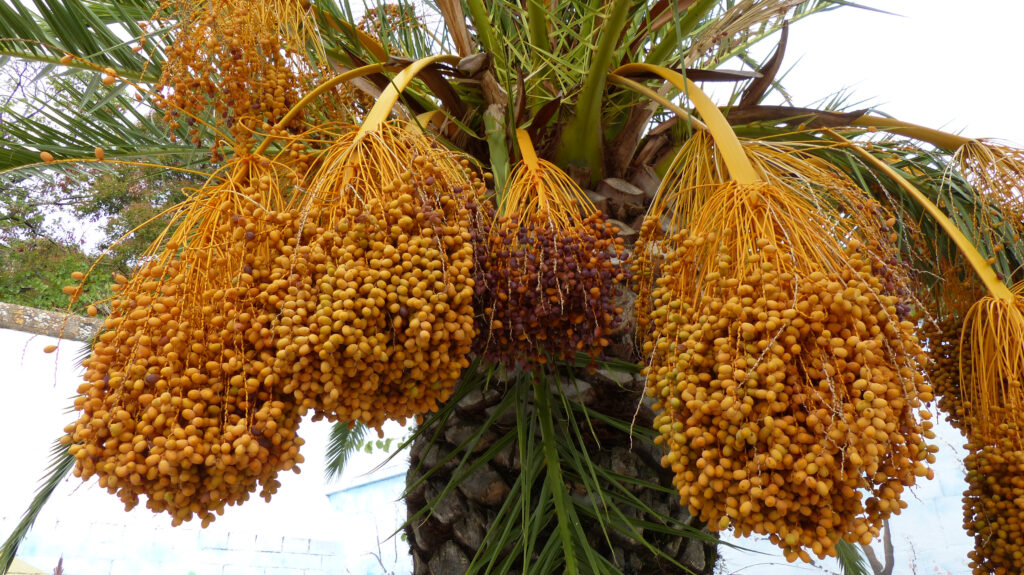
True Date palms have tasty fruit and tolerate drought.
©guentermanaus/Shutterstock.com
The scientific name of the true date palm that produces yummy fruit is Phoenix dactylifera. Date palms are slow-growing, which makes them less favorable for some. They are drought-tolerant trees that handle most soil types and temperatures down to 15 degrees F in USDA Zones 6 to 11.
Blue Hesper Palm Tree (Brahea armata)
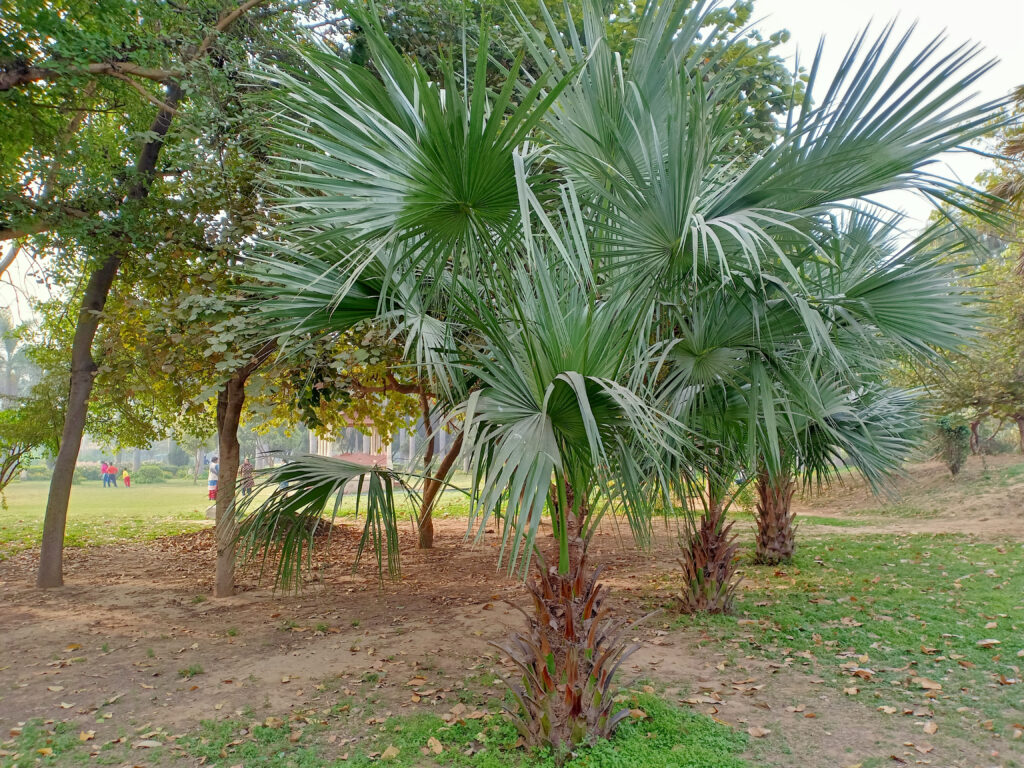
Blue Hesper is native to Baja California and cooler, dryer climates in South America.
©Vipul1989/Shutterstock.com
The Blue Hesper of Brahea armata palm tree is native to Baja California and cooler, dryer climates in South America. The silvery-blue leaves on the tree won’t fade in drought conditions or cooler temperatures reaching down to about 15 degrees F. The tree is a newcomer in cultivation so may be a bit more expensive than some other varieties, but the beauty is worth it if you’ve got the budget. The tree can hit heights of 50 feet.
European Fan Palm Tree (Chamaerops humilis)
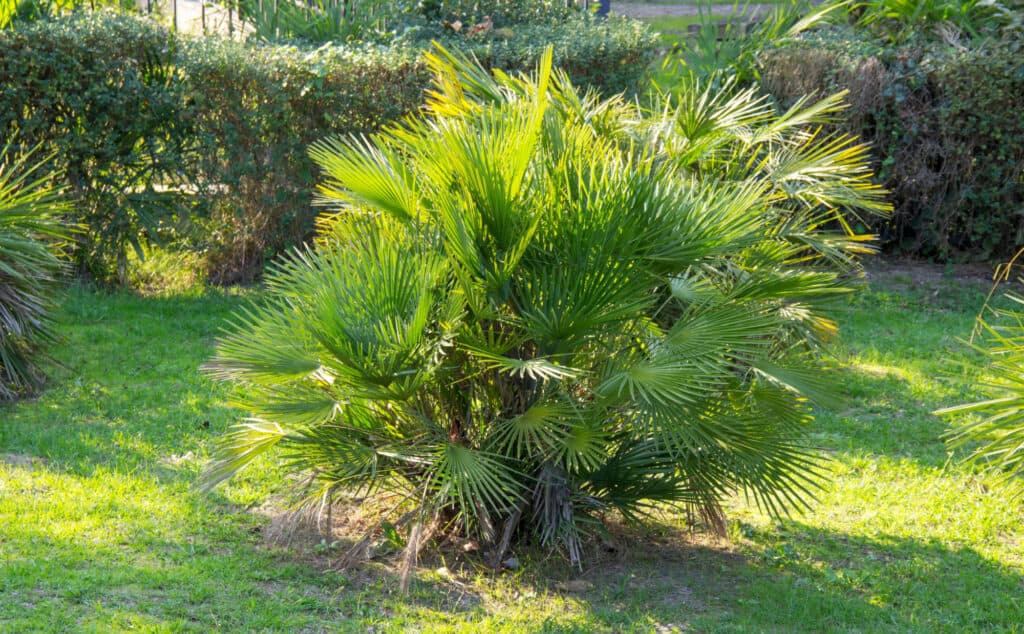
Compact and cold-hardy, the European fan palm is wildly popular.
©ToKa74/Shutterstock.com
Also known as the Mediterranean Palm, the European Fan palm is a slow-growing palm tree native to the Mediterranean and northern Africa. The tree, scientifically known as Chamaerops humilis is a “group” trunk tree, producing up to eight shorter trunks over time from the primary trunk, with shrub-like growth patterns. The tree endures temperatures down to 15 degrees F normally and can tolerate the occasional drop all the way down to 3 degrees F. It’s best for USDA Zones 7b to 11.
Blue Mediterranean Fan Palm Tree (Chamaerops humilis v. cerifera)
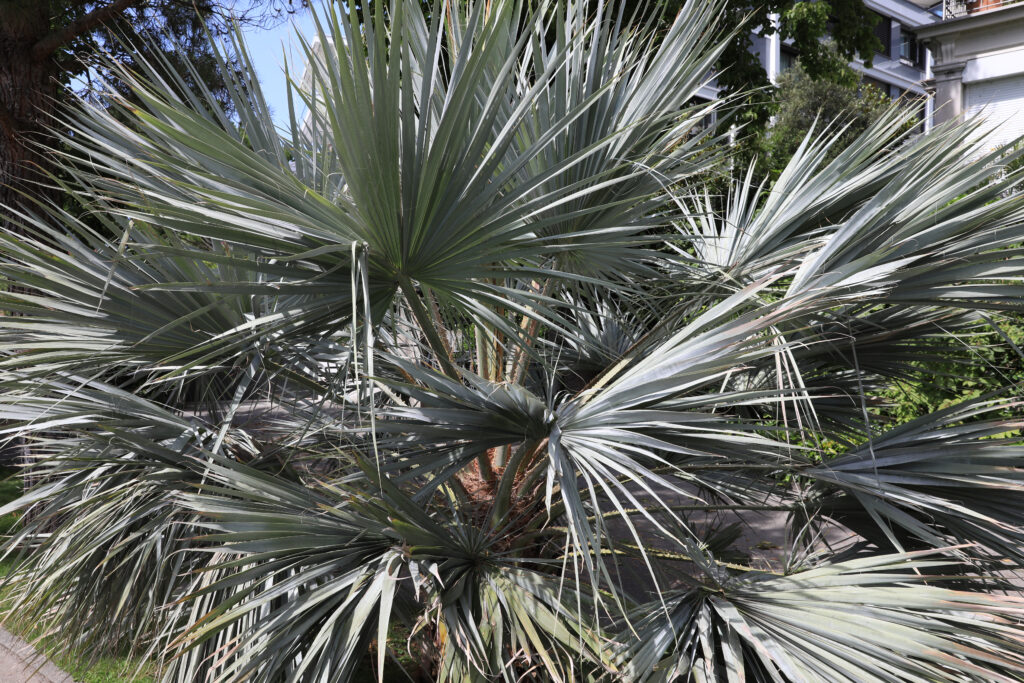
Blue Mediterranean fan palm have silvery sheen to their leaves.
©Traveller70/Shutterstock.com
A variety of the European Fan palm is the Blue Mediterranean Fan palm, or the Chamaerops humilis v. cerifera. This one does well down to 5 degrees F normally, in USDA Zones 6 to 11, natively comes from the Atlas Mountains of Morocco, and is a slow-grower that hits up to 15 feet in height.
Pindo Palm Tree (Butia capitata)

A lone pindo palm tree growing near the sea.
©iStock.com/viktor2013
Native to Brazil, Uruguay, and Argentina, the beautiful Pindo Palm tree is one of the most cold-hardy palms around, with feather-shaped leaves in blue-green. The tree is nicknamed the Jelly Palm, as well, and is easy to grow. It tolerates temperatures down to 5 degrees F, though leaf damage starts to occur around 15 degrees F. It can technically survive brief periods of 0 degrees F, but will lose its foliage. The tree is a slow-grower and known as Butia capitata scientifically. The palm is a stocky tree with a large crown of those gorgeous fronds and produces spiky yellow blooms that produce edible plums with a citrusy-sweet pineapple-like flavor every fall. It grows well in coastal New Jersey and British Columbia.
Queen Palm Tree (Syagrus romanzoffiana)

The queen palm reaches upward into the blue beyond.
©alybaba/Shutterstock.com
The Queen palm, or Syagrus romanzoffiana is a hardy, slow-growing palm that handles temperatures down to 25 degrees F. The straight-trunked tree grows feathery fronds that arch into a fluffy canopy above. The tree is also known as the Cocos Palm and comes from subtropical climates in South America, like parts of Brazil.
Windmill Palm Tree (Trachycarpus fortuneiis)

The windmill palm is native to China and Japan.
©rSnapshotPhotos/Shutterstock.com
The Windmill Palm, or Trachycarpus foruneiis grows natively in northern India, Thailand, southern China, Myanmar, and Nepal. The tree thrives in mountainous terrain and cold temperatures, even under heavy, regular snowfall. The tree doesn’t require hot summers to warm up, either, but survives perfectly well in cooler climates year-round. It’s a great choice for Pacific Northwest growers. The tree does well down to 5 degrees F and can survive down to -10 degrees F on occasion. Leaf damage will occur around 10 degrees F. The tree has massive leaves growing from a single stem.
Cabbage Palm Tree (Sabal palmetto)

The cabbage palmetto has a thick, fibrous trunk that supports its large fronds.
©iStock.com/JillianCain
The Sabal palmetto or Cabbage Palm is native to subtropical climates like the far southern coastal regions of North Carolina, Florida, the Gulf of Mexico coast, and throughout the Caribbean. The beautiful tree is durable down to 10 degrees F, when mature enough, and can survive, with covering, down to 0 degrees F on occasion. The tree is a slow-growing palm that also tolerates drought and thrives in USDA Zones 8 and 9, even into 7.
Texas Sabal Palm Tree (Sabal mexicana)
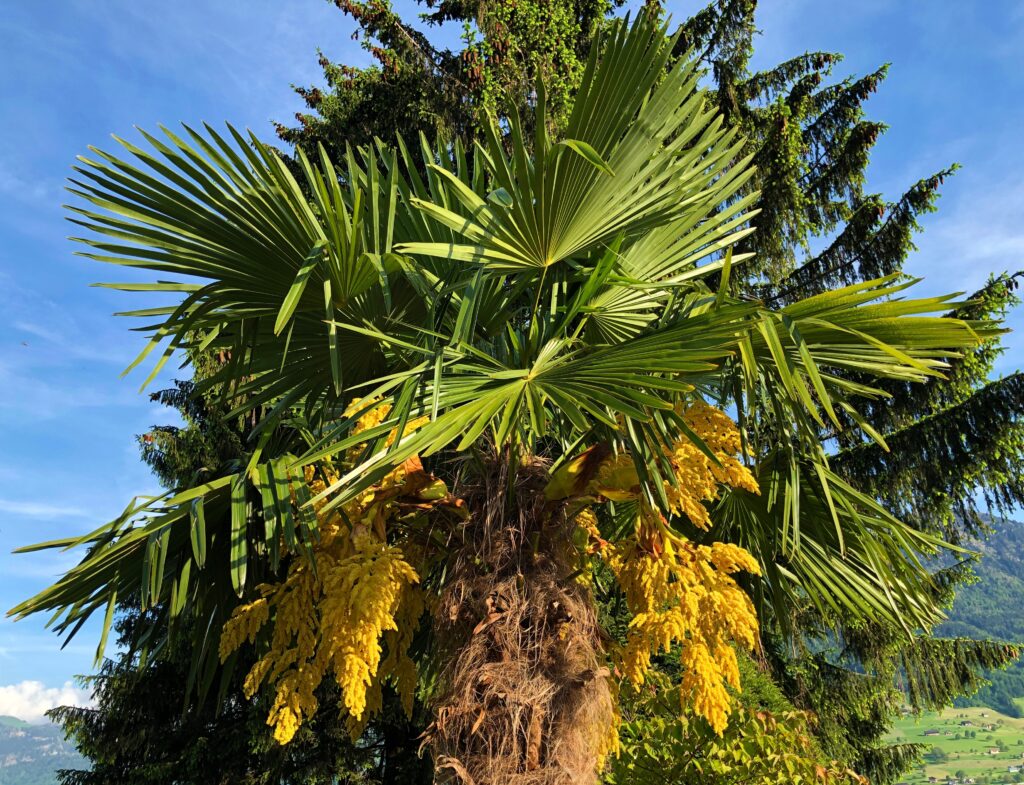
Texas Sabal palm grows natively in southern Texas and northern Mexico through Central America.
©Mario Krpan/Shutterstock.com
Known commonly as the Texas Sabal Palm, the Sabal mexicana or Sabal texana grows natively in southern Texas and northern Mexico through Central America. The true looks a bit like the Sabal Palm, except the Texas Sabal has a thicker trunk and larger leaves. The tree can handle temperatures down to 10 degrees F but damage occurs below that. The tree thrives in USDA Zones 7 to 11.
Canary Date Palm Tree (Phoenix canariensis)

The incredible foliage of the Canary Date makes it an extremely popular tree.
©ghostkaa/Shutterstock.com
The Phoenix canariensis or Canary Date Palm grows natively in North Africa and the Canary Islands (earning it the nickname). The tree has a crisscross pattern on the trunk and a huge crown of leaves. The tree is slow-growing and tolerates a wide range of soil conditions and may tolerate temperatures down to 15 degrees F when uncovered. It does best in USDA Zones 8b to 11, though with winter protection survives in 8a. The tree is also known as the Pineapple Palm, though it does not produce pineapple fruits. It’s actually a relative of the true date palm tree.
Puerto Rican Thatch Palm (Coccothrinax alta)
The Puerto Rican Thatch Palm, or Coccothrinax alta, as it’s known scientifically, is a beautiful palm that’s exceptionally popular for growers in USDA Zones 8 to 13. The tree withstands temperatures down to 28 degrees F uncovered and slightly colder when properly covered for the winter. The tree is often selected for coastal growing and grows between 12 and 25 feet tall.
Sylvester Date Palm Tree (Phoenix sylvestris)
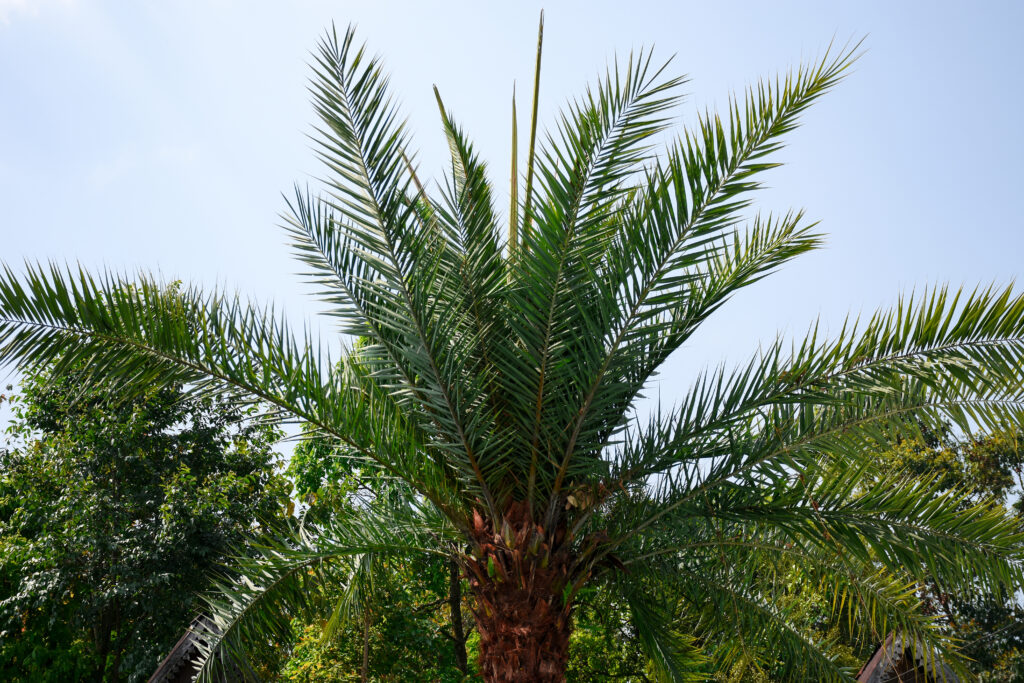
The Sylvester date or silver date palm offers loads of luxury through its incredible aesthetics.
©PHOTOZON/Shutterstock.com
The Phoenix sylvestris or Sylvester Date Palm is a luxury palm often used in golf courses, at resorts and hotels, and in larger, luxury home estates. The tree is a slow-grower that thrives in USDA Zones 8b to 11 and tolerates temperatures down to 15 degrees F.
Saw Palmetto (Serenoa repens)
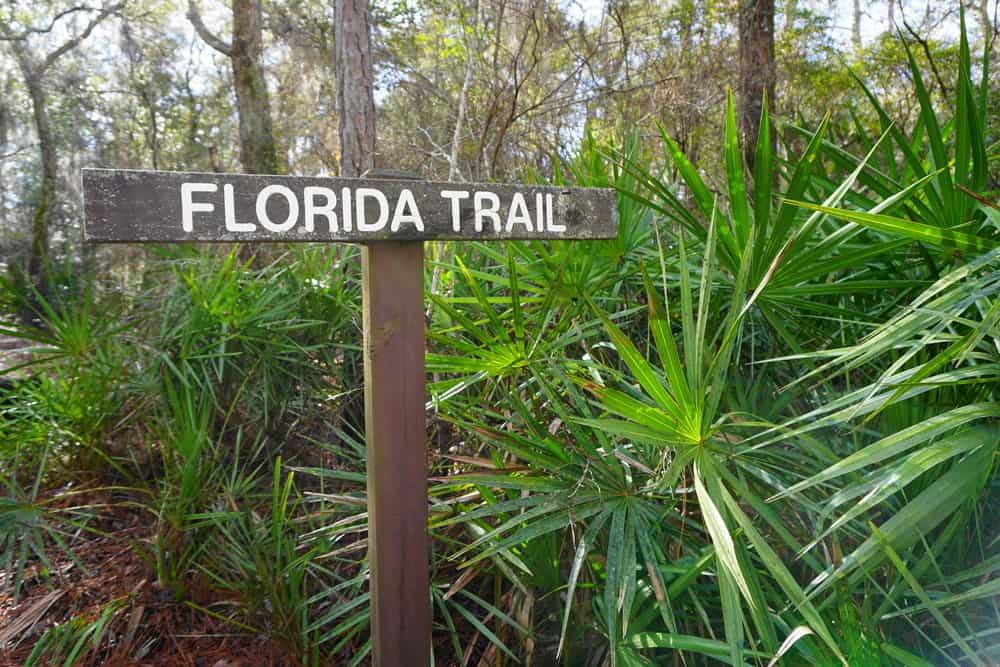
Saw palmettos grow natively in the forests of North Florida.
©Shannon Carnevale/Shutterstock.com
Also known as the Sabal Palm, the Saw Palmetto Palm or Serenoa repens is native to Florida and grows wild among the forests in the northern part of the state and on southward. The tree also grows in other parts of the southeastern USA. The tree is quite cold hardy, tolerating temperatures down to 0 degrees F. It does best in USDA Zones 7a to 11. The tree is named the Saw Palmetto for the sharp protective teeth that line the plant’s petioles (the stalk that joins the leaf to the stem). They produce reddish-black fruits that feed moths and butterflies.
Mexican Fan Palm Tree (Washingtonia robusta)
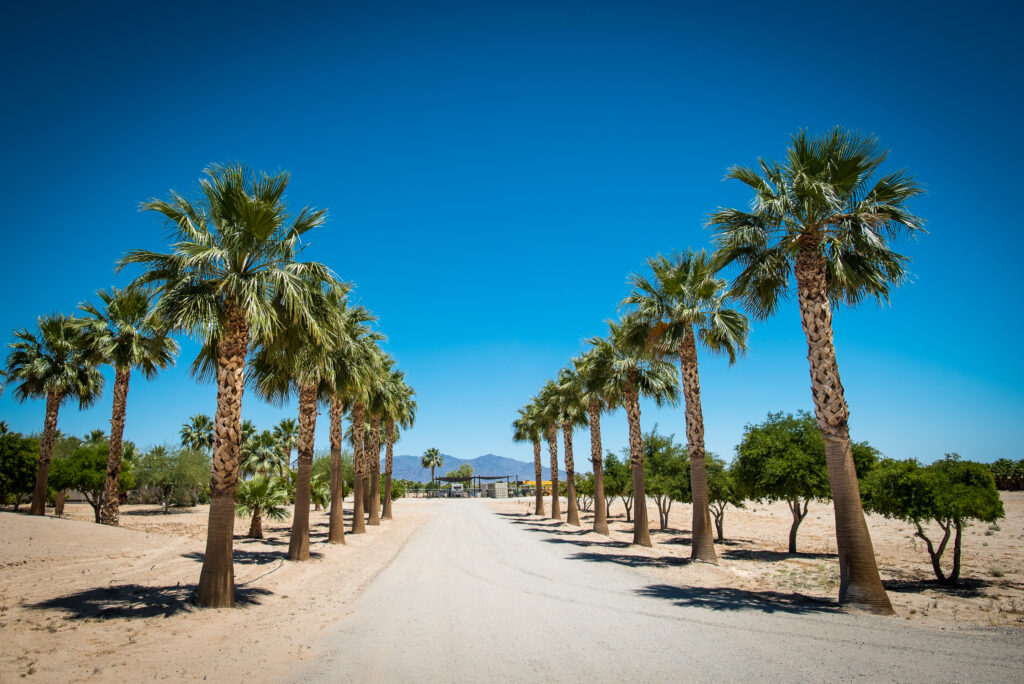
Mexican Fan palm trees are often used to line roadways and lanes.
©Papuchalka – kaelaimages/Shutterstock.com
The Washingtonia robusta or Mexican Fan Palm is a cold hardy tree that’s native to the desert regions of Mexico, earning it the name. It handles drought and cold and dry climates and doesn’t do great in cold humid climates. The Mexican Fan Palm tolerates temperatures down to 15 degrees F, when mature, and down to 0 degrees F when covered and mulched heavily. The tree does best in USDA Zones 8 to 11, as long as it has full sun and properly draining soil. These are the trees, by the way, along Sunset Strip in L.A. in all those iconic film scenes. They reach up to 100 feet tall and are known to live for 500 years or more, when living in the right conditions.
California Fan Palm Tree (Washingtonia filifera)

As the California fan palm matures, the leaves that die hang down against the trunk.
©Jack N. Mohr/Shutterstock.com
Similarly, the Washingtonia filifera or California Fan palm tree thrives in USDA Zones 8a to 11. It tolerates temperatures down to 15 degrees F. The tree is native to California, earning its name for it, but also does well in dry cool conditions that are sometimes found in Oklahoma City and Tulsa. It cannot handle cold and humid climates. These trees are much smaller than Mexican Fan Palms, only reaching about 12 feet in height.
Sago Palm Tree (Cycas revoluta)
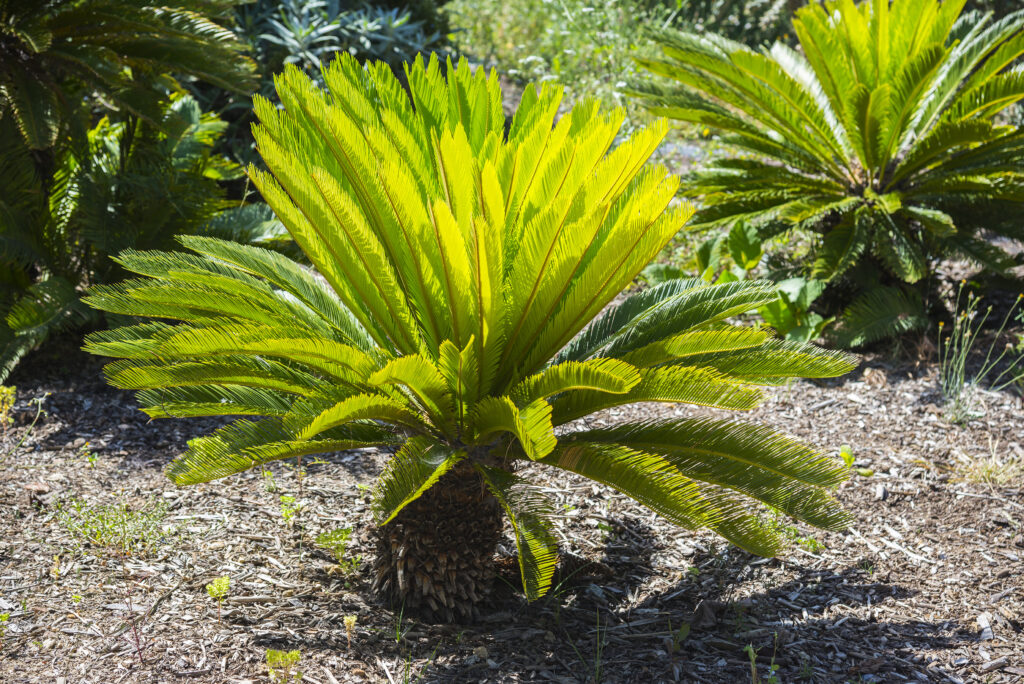
A Cycas revoluta or sago palm tree growing outside among other plants.
©iStock.com/kornyeyeva
Known as Cycas revoluta scientifically, but commonly as Sago Palm trees, these gorgeous trees are not technically palms but actually cycads, which have similar appearances. The slow-growing tree is among some of the most popular “palms” used in landscaping. They tolerate temperatures down to 15 degrees F in USDA Zones 8b to 11.
Dwarf Palmetto (Sabal minor)
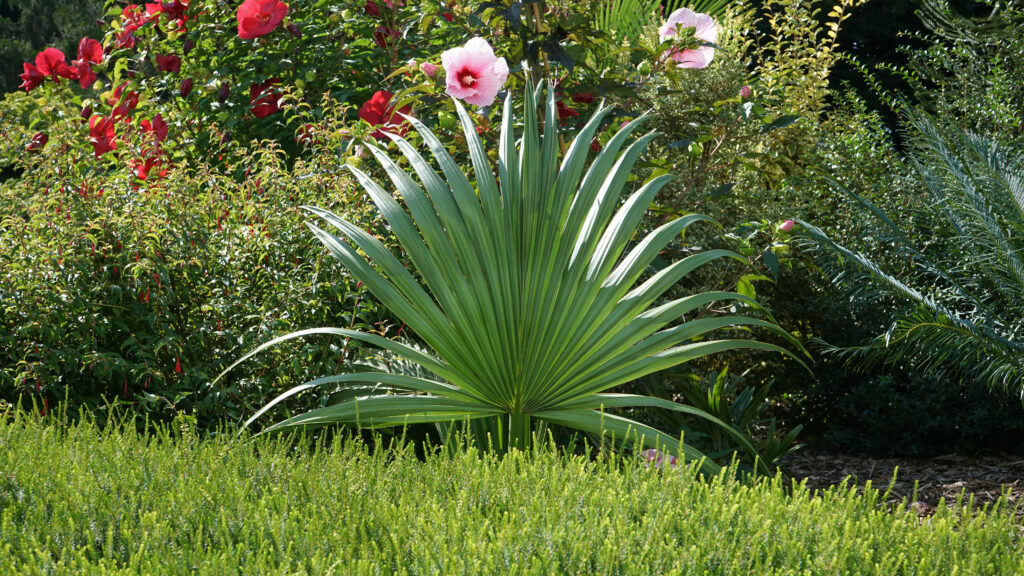
The dwarf palmetto is one of the smallest palm options you can grow.
©Dusan UHRIN/Shutterstock.com
The Sabal minor or Dwarf Palmetto, is a smaller palm tree species that’s native to northeastern Mexico and certain parts of the southeast and south-central USA. The small tree is cold tolerant down to 0 degrees F and has even been known to survive temperatures down to -5 degrees F. It does well in USDA Zones 7b to 10a, in full sun or shaded areas. They do well in humid areas and swamps, handles many types of soils, and is known to do well in places like Wichita, Kansas.
Needle Palm Tree (Rhapidophyllum hystrix)

The needle palm is one of the most popular of all palm trees.
©Sanyawadee/Shutterstock.com
The Needle palm or Rhapidophyllum hystrix is a coastal palm from the southeastern United States. The tree does best in climates that have hot summers yet tolerates living in regions with regular snowfall. They survive down to -10 degrees F when mature, though its best only down to -5 degrees F. They are known to survive as low as -24 degrees F, even in locations like northern Ohio, New England, and Michigan. The tree does best in USDA Zones 5b to 11.
Mazari Palm Tree (Nannorrhops ritchiana)

Mazari palms are nearly as cold hardy as the Needle palm.
©Vipul1989/Shutterstock.com
The Mazari Palm or Nannorrhops ritchiana, is almost as cold hardy as the Needle palm that tolerates severe negative temperatures. The tree is native to Pakistan and Afghanistan and has only in more recent years begun to gain in popularity. The Mazari Palm tolerates temperatures down to 10 degrees F easily and survives, with protection, down to 0 degrees F. It adapts to many soil conditions but does better in dry cold than humid cold.
The photo featured at the top of this post is © Papuchalka - kaelaimages/Shutterstock.com
Thank you for reading! Have some feedback for us? Contact the AZ Animals editorial team.






